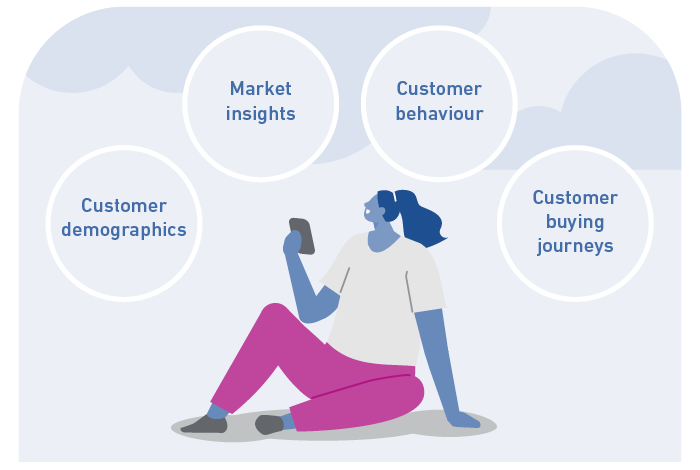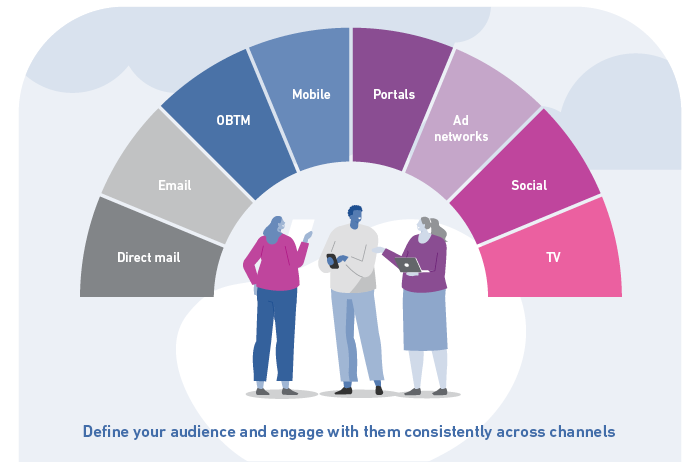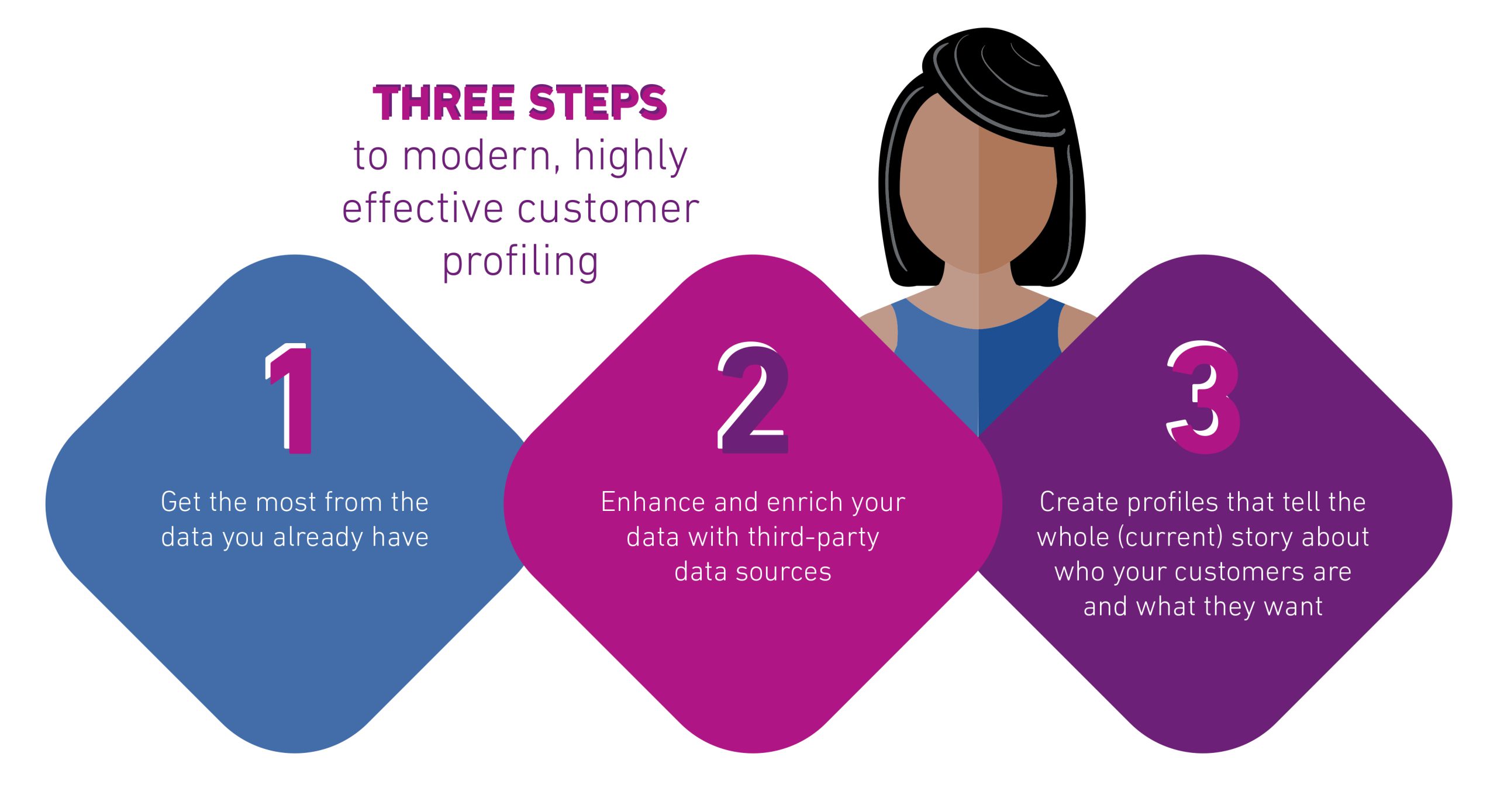How to build a customer profile for effective marketing
Optimise your customer profiling to get a 360° view of your best customers, personalise your marketing, and maximise your conversion
Today’s customers expect communications and offers to be relevant and, wherever possible, personalised. That means, as marketers, we need to recognise the need to really get to know our customers, and to treat each and every one as an individual, with unique needs and preferences.
The way to achieve this is to build a powerful consumer data profiling strategy. By collecting and connecting with consumer data – including customer buying histories, demographic information, location, media engagement metrics, and more – it becomes possible to create accurate customer profiles and to use segmentation to target different types of customers based on common traits, characteristics, and behaviours.
What is a customer profile?
A customer profile is a detailed description of your current customers based on their demographic information, geographical location, purchasing behaviours, or the likelihood to use certain products and channels.
Marketers often make references to customer personas; however, in the main these tend to be built on supposition and projection or historic small scale market surveys. Customer profiles are more valuable than personas as they’re based on factual information about your actual customers. This provides a clearer view of their pain points and a better understanding of the products and services they may be interested in.
Customer profiles can be created for your general customer base or for specific groups that your organisation is interested in e.g. high value customers, customers who are buying a new product or service, those most likely to buy online versus instore. By analysing more granular groups, your company can better understand wants and needs of key ‘segments’, increasing personalisation and engagement and helping to maximise lifetime returns on customer relationships.
What is customer profiling based on?
Customer profiling is the process of research, data integration and analysis that enables the creation of effective customer profiles. Customer profiling software can help to automate the creation and ongoing management of customer profiles. To ensure success, the customer profiling process should take account of the widest possible range of customer data across four key customer characteristics.
- Customer demographics
This looks at customers’ geographical locations, age, gender, household income, presence and age of children, alongside additional information such as preferences in terms of channel and brand utilisation. - Market Insights
This considers how customers tend to operate outside of the organisation for example what types of channels they generally use, brand preferences and products and services they’re likely to use. - Customer behaviour
This considers how customers are transacting with your own organisation e.g. how often they’re interacting, which products they’re buying. - Customer buying journeys
This analyses how customers engage across your own channels e.g. which channels do they use, are they online or offline, source of acquisition and email preferences and interaction.

All these aspects feed into a organisations ability to build a marketing profile and understand audiences – some data will be readily available whilst demographic and market insights are likely to need to be sourced externally.
Why is customer profiling important?
Comprehensive, accurate customer profiles can help companies make the best, data-driven business decisions and improve their overall performance. Specifically, understanding customer needs and preferences enables your brand to:
- Optimise new product development decisions
– based on insights into what your customers want and need. - Increase customer engagement and loyalty
– with communications, content and offers that are highly relevant and attractive for your ideal customer profile. - Measure and benchmark business performance
– based on commercial performance versus the size of the prospective market for your products and services. - Improve marketing efficiency and return on investment
– with the ability to focus 100% of resources on the target market of customers who meet your ideal customer profile. - Implement successful account-based marketing initiatives
– based on in-depth insights into the needs and preferences of individual customers or customer segmentation.
Why is customer profiling essential to your marketing strategy?
Customer profiles help you connect with consumers and groups that share common traits, characteristics, and behaviours. That means you can get away from ineffective ‘spray and pray’ approaches to customer communications and create ‘better-fit’ targeted and personalised experiences and content that maximises conversion across all channels.
Another key benefit of customer profiling for marketers is the ability to find and target your most valuable customers. You can also use consumer profiling to identify target customers with a similar profile, helping you to drive engagement and – ultimately – to create new lead-generation, selling opportunities and revenues.
More than ever, marketers need accurate up-to-date analytical insights to understand, identify, locate, and target their prospects and customers.
Debbie Oates, Director of Customer Engagement, Experian
Using marketing customer profile data, you can define the ideal target market audiences for your communications, content and campaigns, and personalise interactions with customers. This improves their experience and makes them feel valued, leading to long-term brand loyalty and increased returns on customer relationships.
Finally, but equally importantly, a good appreciation of the target audience based on marketing profiling provides the potential for more effective and efficient campaigns. This, in turn, drives higher response rates and, ultimately, increases sales and return on investment.

How to build a customer profile
To create customer profiles that deliver the greatest possible value, brands need to update their consumer data strategies. Here are three ways to ensure your customer profiling can keep pace with shifting markets and customer preferences.
- Get the most from the data you already have
The best place to start with your consumer profiling strategy is to consolidate and enrich the data you already hold about your customers. Make sure your data is accessible, verified, and usable, and create a single view of your customers by deleting duplicate entries. Starting with information such as customers’ names, addresses, and length of relationship with your business, you can add enriching insight such as revenue per customer, product mix, times they visit stores or purchase goods, favoured communication and purchase channels, and more. This way, you can start to understand what makes your customers tick and ensure that your campaigns and channels are appropriate for their needs and preferences. Much of this can be achieved with tools that are inexpensive and readily available, making the process accessible for companies of all kinds and sizes. - Enhance and enrich your data with third-party data sources
When it comes to creating targeted and personalised marketing, your own data can only take you part of the way. This is because the context provided by external data is critically important for understanding your customers in a comprehensive yet granular way, and for creating actionable insights that drive engagement and revenues. For example, external data is needed to understand what your customer base looks like in terms of demographics, home ownership, behaviours and preferences, income and spending, and a host of other characteristics that help you refine your campaign strategy. For example, you may have two customers who purchase the same product (e.g., a television); however, one customer may live in a large, detached property whilst the other lives in a small, one-bedroom flat. This additional insight can help you to understand their wider needs and further enrich your own data. - Create profiles that tell the whole (current) story about who your customers are and what they want
Once you have rich internal and third-party data about your customers, you need a way to understand how they compare to, and what makes them different from, the average person on the street. In other words, are your customers typically younger or older than the national average, are they wealthier or less wealthy, and are they more likely to be married or single than the norm?Finding the answers to these questions requires you to create profiles for each customer type or segment and compare them against each other and the population as a whole. By understanding the full gamut of customer ‘types’ based on a wide range of demographic, economic, geographical factors alongside population attitudes and behaviours very quickly converts your customer data into actionable insights.
In summary, to translate macro-consumer trends into action, marketers need additional ‘lenses’ to deliver a greater depth of understanding. That means understanding customers through both consumer and social data, and through financially focused segmentation as well.

How to use your customer profiles
Once you have the fullest possible picture of who your best customers are, and you know exactly who you’re targeting, it becomes far easier to build successful, cross-channel campaigns.
As well as ensuring that your offers are tailored for the desired customer market segment, you can also improve the relevancy of your messaging – whether that’s email, social, direct mail, connected TV or pay-per-click digital advertising – to increase efficiency and customer engagement. You can also measure the effectiveness of your campaigns over time by customer group to accurately calculate your return on investment.
While consumer profiles are critical for effective marketing, they’re also a major asset in many other business areas, from customer-facing service and support to new product development and location-based planning strategies. For this reason, the outputs from profiling initiatives should always be distributed across the entire company to achieve the best outcomes.
How can we help you?
We can help you identify your best customers, find more of them, and then coordinate seamless and intelligent interactions across the most appropriate channels. For example, Experian Mosaic can help you to deepen customer loyalty, strengthen brand advocacy and maximise profits. Being effective across all channels – from traditional offline to digital TV and online display – the Mosaic consumer classification enables accurate and consistent targeting, so consumers receive content that’s relevant to them.
Find out how our broad range of datasets and tools can help you uncover your best prospects and find more like them – enabling you to reach the right people with the right message at the right time – every time.










